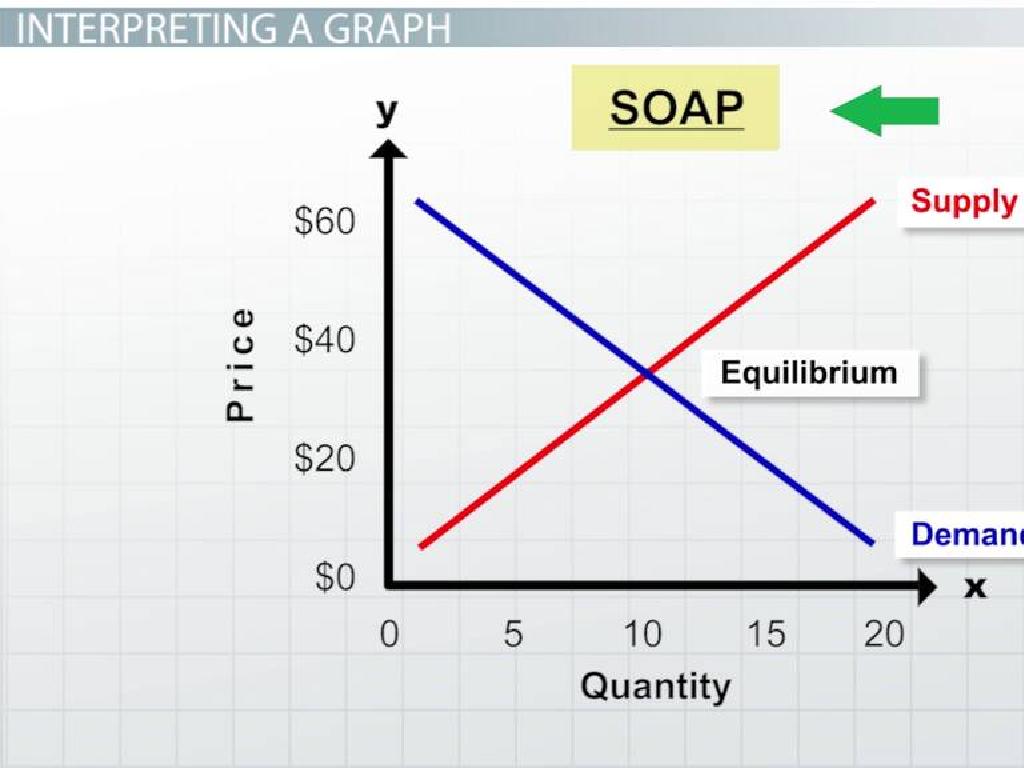Calculate Mean Absolute Deviation
Subject: Math
Grade: Eighth grade
Topic: One-Variable Statistics
Please LOG IN to download the presentation. Access is available to registered users only.
View More Content
Understanding Variability: Mean Absolute Deviation
– What is Mean Absolute Deviation?
– It’s the average distance between each data point and the mean of the dataset.
– Calculating the mean of data
– Add all numbers together, divide by the count of numbers.
– Measuring variability around the mean
– Find the absolute value of differences; then find their mean.
– Significance of Mean Absolute Deviation
– Helps understand consistency and predictability in data.
|
Mean Absolute Deviation (MAD) is a statistical measure that indicates how spread out the values in a data set are around the mean. To calculate MAD, first find the mean (average) of the data set. Next, subtract the mean from each data point to find the deviation of each point. Take the absolute value of each deviation to avoid negative numbers. Finally, calculate the mean of these absolute deviations to get the MAD. This measure is important because it provides a simple way to quantify variability, which can be crucial for making predictions and understanding the reliability of data. Encourage students to practice with real data sets and to understand how MAD can be used in various real-world scenarios.
Understanding Mean Absolute Deviation
– Define Mean Absolute Deviation
– It’s the average distance between each data point and the mean of the data set.
– Its usefulness in statistics
– It shows how spread out the values are from the mean, indicating consistency.
– Real-life example: daily temperatures
– Compare daily temperatures to the monthly average to understand variability.
– Calculating Mean Absolute Deviation
– Add up the absolute differences between each data point and the mean, then divide by the number of data points.
|
Mean Absolute Deviation (MAD) is a statistical measure that helps us understand the variability within a data set. By calculating the average distance between each data point and the mean, students can grasp how consistent the data is. For example, by comparing daily temperatures to the average monthly temperature, students can see how much the daily temperatures fluctuate. When calculating MAD, ensure students understand the concept of absolute value and why it’s used in this context. This slide will help students apply the concept of MAD to real-life situations, enhancing their understanding of statistics.
Calculating the Mean
– Sum all numbers in the data set
– Divide sum by the count of numbers
– Mean represents the average value
– The mean gives us a central value for the data
– Example: Mean temperature calculation
– If temperatures are 72, 76, 73, 68, 71, add and divide by 5
|
When calculating the mean, or average, of a data set, start by adding all the numbers together to get the sum. Next, divide this sum by the total number of data points you have, which gives you the mean. The mean is a measure of central tendency that can give us an idea of the ‘middle’ value of the data set. For example, to find the mean temperature from a set of five temperatures, add all temperatures together and then divide by five. This will give you the mean temperature. Ensure students understand that all numbers in the data set contribute equally to the mean, and it’s a useful way to summarize a set of data with a single number.
Understanding Absolute Value
– Absolute value definition
– Distance from zero on a number line
– Negatives turn positive
– Example: |-3|
– |-3| transforms to 3
– Relevance to mean deviation
– Absolute value is used to calculate deviations
|
This slide introduces the concept of absolute value, which is a critical component in understanding mean absolute deviation. Absolute value represents the distance of a number from zero on the number line, regardless of direction. It’s important to highlight that negative numbers are converted to positive when considering absolute value, as this will be essential when calculating mean absolute deviation later on. Provide the example |-3| = 3 to illustrate this concept. Emphasize that understanding absolute value is necessary for students to grasp how to calculate the mean absolute deviation, as it involves finding the average distance of each data point from the mean of the data set.
Calculating Mean Absolute Deviation
– Subtract mean from each data point
– Apply absolute value to differences
– Example: Mean temperature deviations
– If mean temp. is 70°F, and we have 68°F and 72°F, deviations are |68-70|=2 and |72-70|=2
– Sum deviations and divide by total
– Add all absolute deviations and divide by number of data points to find the mean absolute deviation
|
This slide introduces the steps to calculate the mean absolute deviation (MAD), a measure of variability in a data set. Start by explaining the concept of deviation, which is the distance of each data point from the mean of the data set. Emphasize the use of absolute value to avoid negative differences canceling out positive ones. Use the example of daily temperatures to illustrate how to calculate deviations from the mean. After finding all deviations, guide students to sum them up and divide by the number of data points to find the MAD. This gives an average ‘distance’ from the mean, providing insight into the variability of the data.
Calculating Mean Absolute Deviation (MAD)
– Sum all absolute deviations
– Add the distances of each data point from the mean
– Divide by total data points
– The number of temperatures recorded
– Example: Temperature data set MAD
– If the temperatures are 70, 72, 71, 69, 74, find the mean, then the deviations, sum them, and divide by 5
|
This slide aims to teach students how to calculate the mean absolute deviation (MAD) of a data set. Start by explaining that absolute deviation is the distance of each data point from the mean of the data set, disregarding the direction (positive or negative). Then, guide students through the process of adding these absolute deviations together to find their sum. Next, instruct them to divide this sum by the number of data points to find the MAD. Use the temperature data set as a concrete example to illustrate the process. Have students calculate the mean temperature first, then find each day’s deviation from the mean, sum these deviations, and finally divide by the number of data points (5 in this case) to find the MAD. This exercise will help students grasp the concept of variability within a data set.
Interpreting Mean Absolute Deviation (MAD)
– Low MAD indicates consistency
– When MAD is low, data points are clustered near the mean, showing less variability.
– High MAD shows wide variability
– A high MAD value means data points are scattered, indicating greater variability.
– MAD measures data variability
– Analyzing data set variability
– Understanding how spread out data points are helps in assessing the reliability of the data.
|
This slide aims to help students understand the concept of Mean Absolute Deviation (MAD) as a measure of variability within a data set. A low MAD suggests that the data points are close to the mean, indicating consistency and less variability among the values. Conversely, a high MAD indicates that the data points are more spread out from the mean, showing greater variability and possibly more outliers. It’s crucial for students to grasp that MAD is a tool for quantifying the average distance between each data point and the mean, providing insight into the overall spread of the data. Encourage students to calculate MAD for different data sets to see how it reflects the spread of the data. This understanding is fundamental in statistics for comparing the consistency of different data sets.
Class Activity: Let’s Calculate MAD!
– Collect height measurements
– Calculate the mean height
Add all heights together and divide by the number of students
– Find the Mean Absolute Deviation (MAD)
Subtract mean from each height, take absolute values, then find their average
– Discuss height consistency
|
In this interactive class activity, students will engage in a practical application of mean absolute deviation by using their own height measurements. First, have each student measure their height. Then, as a class, calculate the mean height by adding all the measurements together and dividing by the number of students. Next, instruct students to find the deviation of each height from the mean, take the absolute value of each deviation, and calculate the average of these absolute values to find the MAD. This will help students understand the variability of their heights. Conclude the activity with a discussion on the consistency of the class’s heights, emphasizing the real-world application of MAD in understanding data sets. Provide additional examples if time allows, and ensure that each student is able to follow along with the calculations.
Conclusion & Homework: Understanding Data with MAD
– Recap on Mean Absolute Deviation
– MAD shows how spread out data is from the mean
– Homework: Calculate MAD for a data set
– Choose any data set, find the mean, and then MAD
– Next Class: Other measures of variability
– Why MAD is important
– Understanding variability is key in statistics
|
As we wrap up today’s lesson, remember that Mean Absolute Deviation (MAD) is a powerful tool to understand the spread of a data set. For homework, students should find a real-world data set, calculate the mean, and then use the mean to determine the MAD, reinforcing today’s lesson. In our next class, we’ll explore other measures of variability such as variance and standard deviation, which provide different perspectives on data spread. Emphasize the importance of understanding variability in data analysis, as it is crucial for making informed decisions based on statistical information.






